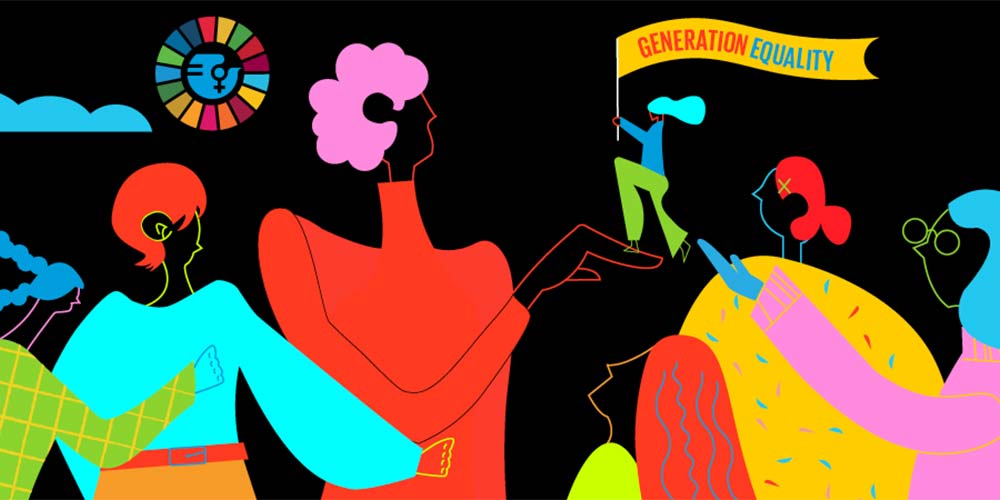Achieving women’s equality in a COVID World: International Women’s Day 2021
COVID and women’s equality
The United Nations announced that the theme for International women’s Day (IWD) 2021 would be ‘Women in leadership: achieving an equal future in a COVID-19 world’. As the accompanying statement points out, women stand in the front lines of the COVID crisis as health workers, caregivers, community organisers and, in some cases, as national leaders in combating the pandemic. But the statement also stresses that this crisis has “highlighted both the centrality of women’s contributions and the disproportionate burdens that women carry”.
Taking this further, ‘The Lancet’, one of the world’s oldest and best-known, peer-reviewed medical journals, published a report detailing the impact of COVID on women. The report draws on global data to stress that, while mortality rates appear to be higher among men, women are bearing the brunt of the social and economic consequences. In this sense, COVID is deepening already existing inequalities. Women earn less, save less, hold less secure jobs, are more likely to be employed in casual roles and work in the informal sector. They have less access to social protections and comprise the majority of single-parent households. All this means that their capacity to absorb economic shocks is generally less than that of men.
In Australia, women have been relatively prominent in the pandemic response, with two female state leaders, female chief health officers, female trade union leaders, as well as a female leader of the Business Council. However, Australian women were already in a weaker position in the workforce, concentrated in low paid casualised work. As well, women have disproportionately withdrawn from the labour market compared to men during COVID. This is the same in the UK where the Institute of Fiscal Studies found that mothers, as a group, where 1-5 times more likely than fathers to have either quit their job or lost it during lockdown.
In large measure, this is caused by women, rather than men, picking up the extra household activities during COVID, including caring for children and supervising their home-schooling. The Australian Bureau of Statistics points out that a carer is three times more likely to be a woman. This finding is underscored by the Institute of Family Studies whose research shows that men’s domestic labour has risen only a little during COVID but women’s has risen a lot. A consequence of this, they conclude, is women withdrawing from higher education at greater rates than men.
But perhaps even more disturbing is the report from the Institute of Criminology who record a significant rise in domestic violence committed by men against women during COVID. In some countries, the surge is now extremely worrying. For example, French authorities have admitted that domestic violence there is up by 30%.
McKinsey’s Women in the Workplace annual report for 2020 concludes by saying all this risks wiping out progress made in gender equality over the last six years, with women who are mothers of school-age children reporting they are spending five or more additional hours a day on household responsibilities. Deloitte’s global survey of working women (including Australian working women) cites that 7/10 women they surveyed believe the social and economic impact of COVID will slow their career down. 45% said they felt overworked and overwhelmed. We risk what’s been termed a ‘she-session’ or a ‘pink recession’.
A crisis exposes existing flaws!
Of course, as with any crisis, COVID (and the changed work arrangements accompanying it), has exposed existing flaws in many instances, rather than creating wholly new problems. Unequal relationships, non-inclusive workplaces, unskilful and unsupportive managers, poor teamwork, a lack of well-being focus, a weak sense of belonging and bad meeting habits all existed previously. There are no new villains in that list! But working from home and the emerging hybrid workplace have certainly exacerbated their impact. What might have been stressful but bearable before has now become intolerable in its impact for many women.
Surveying our clients (women and men), 94% mentioned wanting more connection. 58% said they felt overworked and 60% mentioned needing new skills for these new times. The virtual skills they mentioned were how to collaborate, how to run better meetings, and how to create and maintain both connection and well-being.
But the new hybrid workplace does bring benefits and opportunities for women. In particular, it brings greater flexibility of time and geography. You don’t have to commute as much, if at all. You don’t have to live in an expensive city. You can manage your own work life balance more effectively. These positives are set to deliver the biggest transformation in how work gets done since the Industrial Revolution, mediated by technology and technological innovations.
Yet, as with every opportunity, there are risks and concerns that go along with it. For example, Chaudhury and his team at Harvard have identified a range of concerns expressed by organisational leaders who are moving to this more hybrid way of working, often without the skills needed to ensure success in what for so many is a new endeavour. These concerns include communication, collaboration, knowledge sharing, socialisation and performance management and how all of these can be achieved virtually. But the shift is now inexorable. The world has changed and there’s no going back. COVID has accelerated the shift to hybrid work models and this urgently requires a parallel change in mindset and skills, if we are to capture the upsides and overcome the challenges to benefit the lives of women and indeed of all employees.
What can organisations do?
These days, fair-minded organisations generally want to promote gender equality. Many have worked out that inclusive organisations are also high performing because every employee feels they belong and can contribute their best work. As a concept, then, it’s ‘win-win’, we could say. But the question arises: how best to support women? Sadly, still today, the answer is too often ‘ye olde diversity training’ characterised by a mix of unconscious bias assessment plus bland awareness raising. Yet many studies indicate that anti-bias training does not reduce bias, alter behaviour or change the workplace. So what does work? Harvard sociology professor Frank Dobbin and his team have focused their research energies on this enquiry. They found that the trick is to couple well-designed, behaviour-based, diversity training with a wider program of change. One lever was found to be formal mentoring programs where senior managers are paired with someone from a diverse background, for example a woman, several rungs below them. In UGM experience, a critical point is that it needs to be formal mentoring programs: in other words, mentoring programs which provide evidence-based skills training plus ongoing support to ensure a successful experience on both sides. These days, this can easily be implemented virtually. Managers learn more about the obstacles facing women and this equips them to become champions of diversity. For their part, women build vitally important vertical networks and gain an insight into crucial organisational politics. As Dobbin comments, research now gives us a very good idea about what doesn’t work, as well as what is much more promising.
What can managers do to support the women who report to them?
Managers have a key role to play in all of this. MIT research (led by Michael Watkins) on the future of work has shown that the quality of the one-on-one interactions between managers and their reports makes the difference between success and failure in the hybrid workplace. Yet we know this is an existing weak area, with many women feeling unsupported by their managers and even invisible to them. The hybrid workplace is changing the types of skills a manager needs to lead a diverse, virtual team. Connection, trust and engagement, perhaps unsurprisingly, emerge as the critical determinants of success. A manager or a team leader has to strike the right balance between demonstrating genuine care and micromanaging – something known to sap morale. The spotlight is put on a manager’s coaching skills. This involves the ability to help diverse team members achieve peak performance, while building trust and focusing on well-being and professional development. No easy feat, to be sure! Building and sustaining trust were common themes connecting all the MIT findings. In this, the ability to listen plays a powerful role. Good listening is an often overlooked driver of results. Indeed, having had a manager early in their career who genuinely listened to their experience and aspirations was cited as a ‘game changer’ by executive women interviewed as part of a UGM study.
Men promoting gender equality by becoming allies
Social scientists David Smith and Brad Johnson argue in their 2020 book, ‘Good Guys’, that COVID has forced men (who still dominate leadership roles in most sectors) to realise they need to step up, if organisations are to become more diverse and more inclusive. The evidence they have collected shows that men have a crucial role to play in promoting gender equality at work by collaborating with women as allies. Women’s equitable career progression isn’t a women’s issue alone. They draw on the data they have collected to show how men of goodwill can partner with women to create better workplaces for the benefit of all. So what can men do as allies? Smith and Johnson set out a suite of strategies. Among these is ‘see something, say something’: act decisively in the face of everyday micro-aggressions that, when left unchallenged, accumulate to corrode fairness. They call this ‘watchdog skills’. For too long, men have been the missing ingredient in the equality journey. UGM’s experience is that most men grasp the inclusion argument but have often felt unsure about how they can contribute. This can and should be addressed so that our COVID world can become a much more equitable one.
What can women themselves do?
When we ask our clients to describe a typical day in the COVID world, it is striking how many meetings take place. Many of these are informal and involve only one or two other colleagues. Perhaps, pre-COVID, these informal conversations would have taken place in the kitchen or next to someone’s desk with a cup of coffee in hand. They might not even have registered as ‘meetings’. They were incidental chats that enabled the work to get done by regularly coordinating, sharing and checking things together. Now much of this has to be deliberate and intentional. Taken together with all the other more formal team and stakeholder meetings, it helps to explain why so many women report that a major part of their work day is spent in meetings.
It is unsurprising then that wanting more sophisticated virtual meeting skills was high on the list of the skills identified by our clients in a survey a few months ago. Meetings matter. They are the place where problems are solved, decisions made and actions determined. They are also places where women’s potential and women’s influence are assessed. In this way, they affect women’s careers. As we transition to more and more virtual meetings, there needs to be thought given about how to run them more productively and inclusively. Our research together with research internationally suggests that while we may be mastering the technology, some social issues have begun to emerge. For many women, virtual meetings replicate, rather than resolve, the frequent inequities they experience in organisational life.
The challenge concerns how to secure a valued speaking turn when the usual cues and signals that support conversational flow tend to be more restricted in a virtual setting. Without these subtle moderators, many women report that it’s the loudest and most determined whose voices dominate and become the most influential in their virtual meetings, while those who say little or nothing risk becoming quite literally invisible. But, for women, simply saying more may not be the solution. A Yale study led by Victoria Brescoll identified a further problem. She found that male executives who spoke a lot were seen as more competent but female executives behaving the same way were rated as less competent! The issue is how to get and keep a turn to speak in such a way that you’re considered neither abrasive not passive. If you say too much, you risk alienating others. But if you say too little, you can come across as having little to offer and not suitable for promotion.
In this context, the video on function plays a vital role in enabling your virtual meetings to be high-quality and inclusive, so that business problems can be successfully tackled and useful decisions made. But all too often virtual meetings are being conducted with some or all team members only available to each other in a single channel, audio. The video on function is actually off. A further problem faces women from culturally diverse backgrounds. Different languages have different intonation systems. In some languages, almost every word in a sentence can be highlighted. Speakers of such languages bring this heavy stress pattern to the use of English. They can then sound annoyed or angry, even in a simple exchange. In contrast, in many Asian languages, tone, not stress patterns, affects the meaning and a soft voice can be used to indicate seriousness. In the same situation, English speakers would tend to use a higher pitch and more volume to show key points. These aspects of language are notoriously difficult for people using English as a second or third language to notice and learn.
This is a very important reason why the video on function is so important. If you can see the relaxed and friendly facial expression of your colleague who may sound a little brusque, then the visual signals offset and correct any unintentional negative impression. Body language plays a crucial role in signalling meaning. For all these reasons, a critical way for women to take action to support their own career progression in the hybrid workplace is to ensure they have a sophisticated portfolio of virtual meeting skills. Equipped with such skills, they can position themselves as influential problem-solvers and valued executives.
The way forward
This year’s IWD theme of achieving an equal future for women in a COVID world reminds us that, while there are challenges for women’s career progression in our new hybrid workplaces, there are also opportunities. To make the most of them, women need the support of their organisation and their manager. They benefit from the inclusive everyday behaviours of male allies, and they need, above all, the courage to back themselves by upskilling for this COVID world. It’s a world characterised by risk, instability and complexity. But women can secure a competitive edge by adapting to this new era. For instance, the need for collaboration and relationship-building skills have emerged as critical and surely these have characterised the lives of many women, long before this current crisis!
PRACTICAL IDEAS TO APPLY IN YOUR BUSINESS
Promoting women’s equality at work
- Make use of formal mentoring programs to support women’s competence and confidence to step up. Competence is a critical precursor to confidence.
- Promote the development of listening skills – critical for both highly effective leading and managing, but also for high performing teams.
- If you see something, say something! Act decisively when you observe any micro-aggressions.
- Develop meeting skills to ensure everyone has a chance to step up and share their perspectives. That’s good, not only to develop a sense of belonging, but also to ensure the business is accessing all available brainpower!
- Make use of video on when meeting virtually. This will allow people to access powerful non-verbal cues which would otherwise be missing in an audio only call. Research shows that, when done right, a virtual call with video on is almost as (highly) effective as a physically present meeting.



